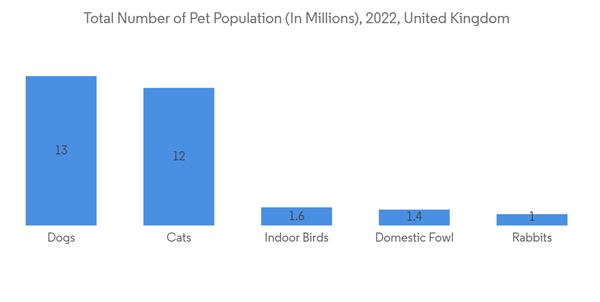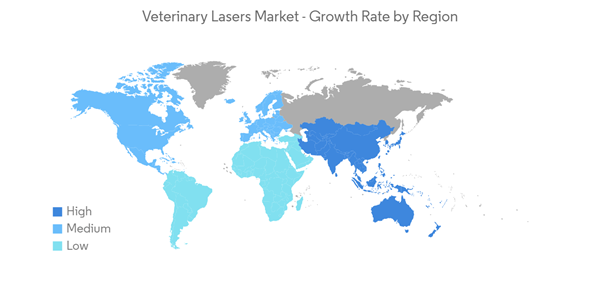Over the next few years, the veterinary laser market is expected to register an annual rate of 8.3%.
The COVID-19 pandemic had a substantial impact on the veterinary laser market. The implementation of lockdowns in several nations, as well as the corresponding limited access to and closure of veterinary facilities, led to a decline in the use of veterinary services, in turn affecting market growth. Due to the forced cancellation and reduction of veterinarian appointments, it was difficult for pet owners to avail proper veterinary treatment for their pets. For instance, as per an article published by NCBI in June 2021, the number of veterinary services in Romania was reduced by 18% during the pandemic as compared to the year 2019. It also stated that working hours were reduced in more than half of the veterinary workplaces among the surveyed population, and 18% of veterinarians received only emergency cases. This indicates that the COVID-19 pandemic was noted to have slightly slowed veterinary laser market growth.
The advancement in veterinary lasers, along with an increase in the number of pet owners, are major factors driving the demand for veterinary lasers. According to a survey published by the American Veterinary Medical Association (AVMA) in November 2021, both dog and cat populations have increased in recent years, as have the percentages of households owning dogs or cats. According to the Pet Food Manufacturers Association, as of 2021, 3.2 million households in the UK had acquired a pet since the start of the pandemic. There are now 34 million pets in the UK, including 12 million cats, 12 million dogs, 3.2 million small mammals like guinea pigs and hamsters, 3 million birds, and 1.5 million reptiles.
For instance, according to an article published in Veterinary Science in January 2021, low-level laser (light) therapy can be used in the treatment of veterinary-related orthopedics, neurology, and wound care. Furthermore, these lasers can be used to treat dermatological disorders such as hot spots, otitis externa, and non-inflammatory alopecia, among others. Thus, low-level laser therapy treatments are gaining popularity in veterinary medicine and have evolved significantly over the past decade. The laser ablates sensory nerve endings, which helps to reduce postoperative pain, according to an article published by the NCBI in March 2022 on developments in veterinary otology.Due to the growing research and development activities, the veterinary laser market is estimated to grow steadily during the forecast period.
Therefore, owing to the aforementioned factors, it is anticipated that the studied market will witness growth over the analysis period.
Therapeutic lasers with advancements in laser technology are a major factor driving the market. For example, in February 2021, Medical Plus introduced M-VET, MLS LASER therapy laser, which aids in the inhibition of pro-inflammatory molecules, produces short and long-term analgesic effects, allowing for a significant and progressive function recovery, improves the quality of newly formed tissue, and speeds up healing times.
Therefore, the therapeutic laser segment is expected to witness significant growth over the forecast period due to the above-mentioned factors.
According to the American Pet Products Association (APPA), in 2021, about 70% of United States households will have a minimum of one pet. The country has witnessed an increase in overall and per capita spending on pet care in the past few decades. Additionally, according to the North American Pet Health Insurance Association (NAPHIA), the 2020 results show total premium volume in the U.S. amounted to $1.99 billion USD, a 27.5% annual increase over 2019. and had more than USD 1.99 billion in gross written premiums in 2020. Pet insurance enables pet owners to efficiently spend on quality care services for their pets and provide them with optimal treatment options.
The increasing number of launches of veterinary lasers by the market's players is also propelling the market's growth. For example, in May 2021, RWD Life Science will launch a new product, the RLT-24 veterinary laser, in laser technologies designed to provide reliable, effective treatment such as pain relief, faster healing, and recovery from injuries for your pet patients, and this product is widely used for the diagnosis, treatment, and surgery of pet patients, as well as relevant basic clinical research.The advanced strategies initiated by animal health key players to identify novel laser technology indicators are further enhancing the opportunity for segment growth.
Therefore, owing to the presence of major players, an increase in pet adoption will propel the growth of the market in the North American region.
This product will be delivered within 2 business days.
The COVID-19 pandemic had a substantial impact on the veterinary laser market. The implementation of lockdowns in several nations, as well as the corresponding limited access to and closure of veterinary facilities, led to a decline in the use of veterinary services, in turn affecting market growth. Due to the forced cancellation and reduction of veterinarian appointments, it was difficult for pet owners to avail proper veterinary treatment for their pets. For instance, as per an article published by NCBI in June 2021, the number of veterinary services in Romania was reduced by 18% during the pandemic as compared to the year 2019. It also stated that working hours were reduced in more than half of the veterinary workplaces among the surveyed population, and 18% of veterinarians received only emergency cases. This indicates that the COVID-19 pandemic was noted to have slightly slowed veterinary laser market growth.
The advancement in veterinary lasers, along with an increase in the number of pet owners, are major factors driving the demand for veterinary lasers. According to a survey published by the American Veterinary Medical Association (AVMA) in November 2021, both dog and cat populations have increased in recent years, as have the percentages of households owning dogs or cats. According to the Pet Food Manufacturers Association, as of 2021, 3.2 million households in the UK had acquired a pet since the start of the pandemic. There are now 34 million pets in the UK, including 12 million cats, 12 million dogs, 3.2 million small mammals like guinea pigs and hamsters, 3 million birds, and 1.5 million reptiles.
For instance, according to an article published in Veterinary Science in January 2021, low-level laser (light) therapy can be used in the treatment of veterinary-related orthopedics, neurology, and wound care. Furthermore, these lasers can be used to treat dermatological disorders such as hot spots, otitis externa, and non-inflammatory alopecia, among others. Thus, low-level laser therapy treatments are gaining popularity in veterinary medicine and have evolved significantly over the past decade. The laser ablates sensory nerve endings, which helps to reduce postoperative pain, according to an article published by the NCBI in March 2022 on developments in veterinary otology.Due to the growing research and development activities, the veterinary laser market is estimated to grow steadily during the forecast period.
Therefore, owing to the aforementioned factors, it is anticipated that the studied market will witness growth over the analysis period.
Key Market Trends
The Therapeutic Lasers Segment Witnessed Dominant Segment Over the Forecast Period in the Veterinary Laser Market.
The therapeutic lasers segment holds a significant revenue share in the veterinary laser market. Cold laser therapy is what therapeutic lasers are.It uses laser light set to wavelengths between 600 and 980 nanometers. It is used to perform minor surgeries and promote regeneration of tissue. Factors such as the growing number of severe chronic diseases in animals and increasing animal welfare and productivity are expected to boost market growth in the region. For example, in June 2022, NCBI published an article stating that osteoarthritis affects approximately 90% of dogs in the United States, resulting in a reduced range of motion, difficulty climbing and jumping, decreased physical activity, and a lower quality of life.Therapeutic lasers with advancements in laser technology are a major factor driving the market. For example, in February 2021, Medical Plus introduced M-VET, MLS LASER therapy laser, which aids in the inhibition of pro-inflammatory molecules, produces short and long-term analgesic effects, allowing for a significant and progressive function recovery, improves the quality of newly formed tissue, and speeds up healing times.
Therefore, the therapeutic laser segment is expected to witness significant growth over the forecast period due to the above-mentioned factors.
North America is Expected to Dominate the Veterinary Laser Market
North America held a notable market share of the veterinary laser market in 2021. The high share of the region is due to the significant presence of key players such as Aspen Laser Systems LLC and Biolase Inc., the adoption of various strategies initiated by key companies to increase market penetration, rising research activities, rising diagnostic rates, and increasing animal population and vet care expenditure. growing demand for therapeutic lasers.According to the American Pet Products Association (APPA), in 2021, about 70% of United States households will have a minimum of one pet. The country has witnessed an increase in overall and per capita spending on pet care in the past few decades. Additionally, according to the North American Pet Health Insurance Association (NAPHIA), the 2020 results show total premium volume in the U.S. amounted to $1.99 billion USD, a 27.5% annual increase over 2019. and had more than USD 1.99 billion in gross written premiums in 2020. Pet insurance enables pet owners to efficiently spend on quality care services for their pets and provide them with optimal treatment options.
The increasing number of launches of veterinary lasers by the market's players is also propelling the market's growth. For example, in May 2021, RWD Life Science will launch a new product, the RLT-24 veterinary laser, in laser technologies designed to provide reliable, effective treatment such as pain relief, faster healing, and recovery from injuries for your pet patients, and this product is widely used for the diagnosis, treatment, and surgery of pet patients, as well as relevant basic clinical research.The advanced strategies initiated by animal health key players to identify novel laser technology indicators are further enhancing the opportunity for segment growth.
Therefore, owing to the presence of major players, an increase in pet adoption will propel the growth of the market in the North American region.
Competitive Landscape
The market for veterinary lasers is emerging and consolidated. Leading players deploy numerous strategic initiatives that include competitive pricing strategies, partnerships, product expansion, sales and marketing initiatives, and mergers and acquisitions. VBS Direct Limited, Spectra Vet Inc., Aspen Laser Systems LLC, Aesculight, Cutting Edge Laser Technologies, Excel Lasers Limited, Biolase Inc., k-Laser LLC, Erchonia Corporation, and Respond Systems are some of the key players in the markets.Additional benefits of purchasing the report:
- The market estimate (ME) sheet in Excel format
- 3 months of analyst support
This product will be delivered within 2 business days.
Table of Contents
1 INTRODUCTION
4 MARKET DYNAMICS
5 MARKET SEGMENTATION (Market Size by Value - USD million)
6 COMPETITIVE LANDSCAPE
Companies Mentioned (Partial List)
A selection of companies mentioned in this report includes, but is not limited to:
- VBS Direct Limited
- SpectraVET Inc
- Aspen Laser Systems LLC
- Aesculight
- Cutting Edge Laser Technologies
- Excel Lasers Limited
- Biolase Inc.
- K-Laser LLC
- Erchonia Corporation
- Respond Systems
Methodology

LOADING...










